|
|
Railroad Keys
In order to use the wide variety of locks that railroads used to secure
switches, signals, buildings, and other facilities, employees were issued
special keys. Such keys were carefully guarded and were carried at all
times on the job. Losing a key was once considered grounds for instant
dismissal, and the story goes that the wife of more than one railroad
man would safeguard his keys while he was off the job lest he lose them
at the local watering hole! Today, keys from long-gone railroads are
much prized by collectors, with rare ones having substantial value.
 Railroad keys were typically made of brass. As with locks, there are
different styles of keys, but the majority of railroad keys were of a
standard size made to fit a switch lock, with the bit customized to fit
the particular locks of each railroad. Typically, keys were marked with
a railroad's name or initials An example is shown above right, marked
for the Northern Pacific Railway and manufactured by Adams & Westlake.A
number of manufacturers made keys for railroad use. Railroad keys were typically made of brass. As with locks, there are
different styles of keys, but the majority of railroad keys were of a
standard size made to fit a switch lock, with the bit customized to fit
the particular locks of each railroad. Typically, keys were marked with
a railroad's name or initials An example is shown above right, marked
for the Northern Pacific Railway and manufactured by Adams & Westlake.A
number of manufacturers made keys for railroad use.
Regarding keys on a small railroad.
Here's a great comment sent in by JB in the Fall of 2010 concerning the use of traditional railroad keys on a small railroad in the 70's: "
When the New Hope & Ivyland RR in Pennsylvania back in 1966 bought an old Reading Company branch, they continued using Reading switch locks. They probably bought the keys from Adams & Westlake, as that's where I bought them when I had storekeeper's duties in the late 1970s. The earlier keys, some of which I know were from Adlake were stamped at the factory N H I R and had a smooth surface. But when I started ordering them, what came was obviously sand cast, with a very grainy surface that made it hard to see the letters, which may have even been part of the mold, instead of being stamped later. There was no manufacturer's marking. I was so disappointed with the appearance that I specified in future orders that they come unmarked. I then used a large bench mounted electric grinding wheel to make one side of the bow smoother. It wasn't a mirror finish, but better than the sand cast look. Now I used a 3/8 inch Sears, Roebuck & Co. lettering stamp set to mark them N H I R, usually in a semicircle instead of a straight line. Since I had to buy 48 at a time, more than we needed, we also sold them to visitors in the Gift Shoppe to avoid tying up so much money for a long time. By that time, ConRail was running the old Reading company lines and using Penn Central locks and keys on them." -JB [Our thanks to JB for this comment, Fall 2010]
Regarding diamond-shaped keys (Posted on our Q&A Board - see #2621 for image)
First, the keys are diamond-shaped as that was the corporate symbol for Fraim-Slaymaker and its predecessor company- Slaymaker Barry. Michael’s key is one of the PQ-series keys made by F-S and later by Slaymaker. PQ keys are numbered from 1 to 144 and each key is a different cut. Following the production of the PQ-series is the PR with as many different cuts. PQ and PR locks were used by the PRR, RDG CO, P & R, Long Island RR and the L & N- to name a few, and were marked with PQ or PR on one lower front side of the shackle and the individual cut number on the other lower side. These locks are either stamped with the railroad’s name on the shackle, or have raised letters on the drop, or have cast brass drops with fancy lettering- in the case of the PRR Co and P&R RR. In some cases, the PQ or PR is not stamped anywhere on the lock, but the cut number consistently is. The locks are marked for either F-S or Slaymaker, or with no manufacturer’s mark. Let me clear up some misinformation here. As a 37-year career railroad employee, I have been in many of what are now ex-PRR, ex-RDG and ex-CRR of NJ towers, yard offices, track gang shanties and storage buildings. It is wrong to say they were very commonly used on small cabinet or desk locks and some smaller padlocks, as they never were intended for these type locks. PQ and PR locks are 3.5” tall and 2.5” wide (not smaller padlocks) and were intended to be utility locks for locking NON-signal department buildings, such as the aforementioned facilities, doors leading to storage rooms in those buildings and steel boxes containing supplies both inside and outside of these buildings. They were never intended for signal cabinets or the equipment in signal towers. The signal departments had their own designated locks for that. Through various means, I am trying to complete the set of all 144 cuts of the PQ and PR series. I find that most of these keys I can find are steel and that the brass ones are those most likely to be marked for F-S. I have yet to find one marked for SBCo, though it may exist. I am not aware of any of the steel or brass ones being marked for Slaymaker. One last thing: PQ and PR series locks were made for other concerns besides railroads, as I have seen locks not marked for any company. As they were quite often galvanized, one can assume that their utility extended beyond the railroad industry. [Thanks to DGK, 10/2013]
Below we present
a variety of key markings from different manufacturers, courtesy of Bill
Kajdzik who kindly provided these digital scans.
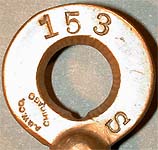 |
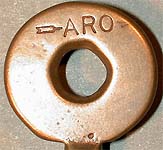 |
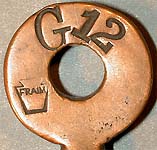 |
| From
left to right: Adams & Westlake Co. (Chicago),
ARO, and C.T. Fraim (Lancaster, PA). |
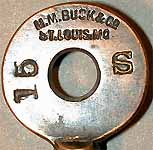 |
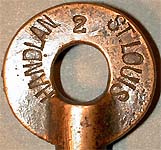 |
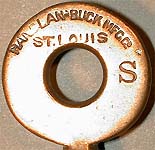 |
| From
left to right: M.M. Buck, Handlan, and Handlan-Buck,
all incarnations of the same company in St. Louis, MO. |
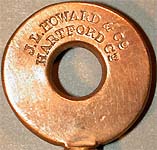 |
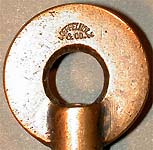 |
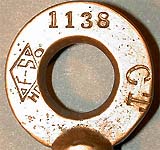 |
| From
left to right: J.L. Howard & Co. (Hartford, CT),
Loeffel Holz & Co, (Milwaukee, WI) and F.S. Hardware Co. (Lancaster,
PA). |
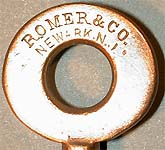 |
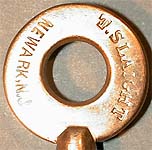 |
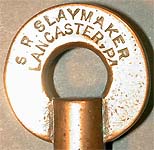 |
| From left to right: Romer & Co.
(Newark, NJ), Thomas Slaight (Newark NJ), and Slaymaker (Lancaster,
PA). |
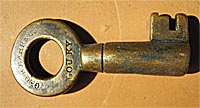 Update 2017. At right is a key made by the George B. Bahr Company of Louisville. It is marked for the Louisville, New Albany & Chicago Railroad. Click on the image for a larger version. Update 2017. At right is a key made by the George B. Bahr Company of Louisville. It is marked for the Louisville, New Albany & Chicago Railroad. Click on the image for a larger version.
Acknowledgments: Thanks to Bill Kajdzik and Patrick McNamara for the photos.
|